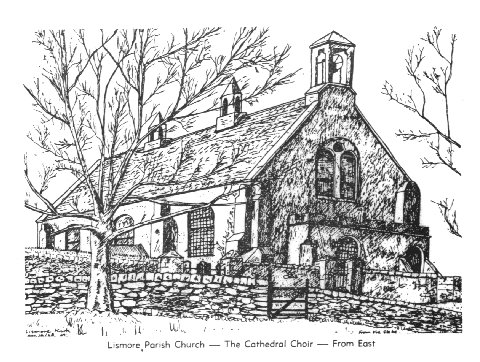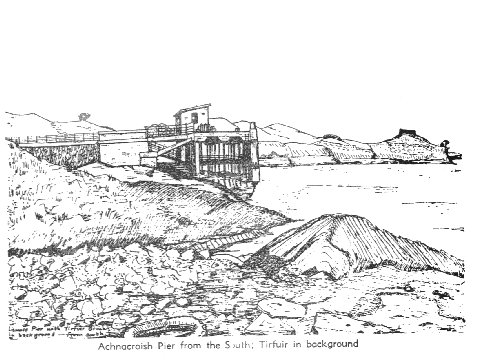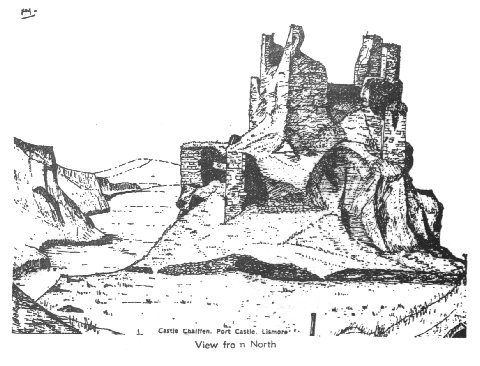THE ISLE OF LISMORE
(extracted from "Isle of Lismore" by Hector Macpherson,
M.A)
Location
| Lismore is a long narrow island, ten miles long
(including Musdile at the S. End) and not over 1½ miles broad.
It lies in the Firth of Lorn at the south end of Glenmore and shares
the S.W. and N.E. axis of the Great Glen. In the distance to the N.E.
Ben Nevis can be seen; on the westerly side rise the hills of Morven;
on the easterly the Benderloch hills with Glen Creran's mountains and
Ben Cruachan behind; and to the south the Firth stretches between Mull
and Kerrera with remoter views of Easdale and the Paps of Jura.
Some History
The first appearance of the island in history is
in 562 (or 563) A.D. when two Irish missionaries, Columba and
Moluag, arrived in the Firth of Lorn with some followers to find
a vantage point for Christian evangelism among the Picts and Scots.
The story goes that the two parties were nearing the shores of
Lismore when Moluag realised that his rival's coracle would beach
first. So great was his anxiety to claim this well-placed island,
that Moluag chopped off one of his fingers and flung it to the
shore, thus touching with his flesh the coveted land before Columba.
The now more famous saint turned wrathfully away, leaving Moluag
to his painful victory.
|  |
The name Lismore comes from lios ( a garden or enclosure)
and mor (large). Some say Lismore was called "the great garden"
on account of the fertility of its valleys and coastal strips;
others refer to the walled enclosure claimed by Moluag when he
set up his religious community at what is now called Clachan.
Before this time the island's name may have been Tirfuir, but
since Moluag it has been Lismore.
The Parish Church
|
Of Moluag's first church no trace remains. It may
have stood where the present one is, or at the highest point of
the present graveyard south of the Parish Church. In the 13th
century a cathedral was begun in stone; finished sometime in the
14th century. It appears to have consisted of choir/chancel
and nave, with a west end tower and a small chapel in the north
side of the chancel. The present church is the altered choir/chancel
in which can still be seen the mediaeval sedilia (clergy seats)
and piscina (basin for washing communion vessels). You enter nowadays
through the east wall where the high alter would have stood. Behind
the present communion table is the old choir and arch, and beyond
the vestry (modern) in the glebe, you can trace the outlines of
the nave walls and the foundations of the little tower at the
west end.
|

|
After the Reformation the choir was used as the Parish
Church - probably in poor repair - and the rest of the cathedral
fell into ruins. In 1749 the floor level was raised by about two
feet, the walls lowered by about nine feet and a new roof erected.
North, east and probably west galleries were required to seat
the worshippers (this was the Parish Church of Lismore, Appin,
Kingairloch etc!) and along communion table was placed along the
centre of the building, the pulpit being against the south wall.
Now only the east gallery remains, the pulpit faces east, and
a modern type of communion table stands in the now conventional
position.
Interesting Buildings
There are several other interesting buildings on
the island, the oldest being the pre-Christian "Pictish"
broch at Tirfuir (pronounced Tirry-foor) , one of a family of
Scottish brochs whose most famous member is at Mousa in Shetland.
On the coast west of Clachan, at the tiny haven of Port Castle,
is Castle Coeffin (or Chaiffen), an old Viking fortress of the
period when Norsemen held all the northern and western isles of
Scotland. South of Achaduin (pronounced Achnadown) is the ruins
of the Bishop's Palace, a castle which was the mediaeval home
of the Bishops of Argyll and the Isles whose cathedral is the
present Parish Kirk.
|

|
|
Where the road to Achaduin leaves the road to Kilcheran
( pronounced Killie-cheeran - "ch" as in loch), there
stands, at what is now called Balligrundle, the old United Free
Church. This attractive little kirk was in use , in summer only,
until 1970, but it used to house an active congregation, the descendants
of the men and women of principle who left the Church of Scotland
at the Disruption of 1843. The principle for which they stood
has long been accepted and the breach healed; both the Church
of Scotland and the U.F. are one Presbyterian community. At Kilcheran,
next to the farmhouse, is a large house built as a Roman Catholic
seminary. Later it became a boarding house popular with visitors,
and now it is in private hands.
In the glebe, across the road from the Manse, is
a "standing stone". It was a marker of the mediaeval
sanctuary area where fugitives could seek ecclesiastical protection.
Nearly a mile N.E. of the Church on the N.W. side of the road
is a curious hollow in the limestone rock. This is "Saint
Moluag's Chair", where he used to sit in fine weather and
meditate. In the glebe, across the road from the Manse,
is a "standing stone". Two relics of the saint which
survive are his bell (in the National Museum of Antiquities in
Queen Street) and his pastoral staff, the Bachuil Mor. The family
of the Livingstones of Bachuil are hereditary keepers of the staff,
and the Bachuil is once more in their custody.
|

|
Two large and interesting homes are Achuaran House, near the north
end (Point), and Bachuil, almost a quarter of a mile north of
the Church.
PEOPLE AND WORK
In 1845 there were 1,430 people living in Lismore; in September
1971 there were 180; Yet the picture is brighter today than some
20 years ago. The drop in population has stopped and a slight
rise has begun. In August 1967 there were a dozen children in
the one-teacher school; today there are two teachers and a new
classroom added to cater for the roll of over 30 pupils.
This is a stable community, not like some rural ones to-day which
have become "dormitories" where people have their homes
but do not work, or shop, or go to school. Neither is it an exclusive
community as some insular ones can be; for, though most of the
residents are Lismore natives, several of the young men have married
girls from the mainland who have settled happily into the environment.
Gaelic is known by most of the people, though fewer families now
use it as the main language. There is no longer a Gaelic service
in the Kirk, and for some time the old tongue had not been heard
in the school. Happily, however, it is kept alive at ceilidhs
where old and young sing the lovely Gaelic songs, and once more
there are young entrants for the Mod.
A strong community feeling exists and is shown by much helpful
co-operation among farmers and housewives, and great willingness
to stand in for anyone ill or growing old. No one need ever be
lonely here. Entertainment and instruction are provided by a lively
badminton club, an intermittent drama group, evening classes at
the school, the Young Farmers' Association, the Woman's Guild
branch, and seasonal events such as clipping competitions, ploughing
matches, and Hallowe'en and Christmas parties.
A modernised and well-stocked shop which is also the Post Office,
is useful to residents and attractive to visitors.
Lismore is linked with Oban and Port Appin. Twice daily, with
extra sailings on Monday and Friday, the 'Loch Toscaig" carried
passengers for a good number of years between Oban and Achnacroish.
In the autumn of 1973 the sturdy little vessel was replaced by
a new car ferry boat, the "Moivern", which, running
to the same timetable meantime, is the beginning of a long-awaited
car link, and should prove most useful to farmers especially.
A small passenger ferryboat crosses the narrow channel between
Point (Lismore) and Port Appin and by this route the doctor comes
to the island on his regular visits and on emergency calls.
A total of just under 12 miles of road on the island can be used
by cars. Some of the surface is fairly good and has been recently
much improved. Around forty vehicles use the roads, some being
tractors. Since no day-trippers can bring cars and since there
is no 'through road" to anywhere, this is an accident-free
area and there is safety for children and animals.
As mentioned earlier, all the people are farmers apart from retired
folk, the teachers, district nurse, shopkeeper, postman, minister,
etc. What a contrast with 1845 when there were bakers, cobblers,
millers, masons, joiners, lime workers, boat builders, fishermen
and coaster crews.' There are only one or two ponies on this island
where once fine grey and dappled horses were produced for export
and, according to the Rev. Gregor MacGregor, the inhabitants were
"famed for their skill as jockeys". Of course, when
there were over 1,000 people, there were inevitably some below
the poverty line; for the land could not carry so many in decent
comfort; but the drop in population has now gone too far, and
the danger always threatens with a pastoral economy that eventually
there will be too few folk to maintain a viable community with
school, church, shop and other needful amenities. Concentration
of industry and policies of centralisation have killed local industries
such as Lismore lime working, and slate quarrying at Ballachulish
and Easdale. And the remedy is not to set up, with Government
bait, branches of English or American spectacle makers or precision
instrument manufacturers' factories which bring no wealth to Highland
folk and will be closed at a breath of cold, economic draught.
The answer is, surely, the sponsored revival of native industries
such as lime, slate, and stone quarrying (we'd have better architecture
as a result!) and - above all - more help to established occupations
such as farming, forestry and fishing, e.g. in the shape of reduced
freight charges and better shipping services with assured rail
and road links.
Our Highland and Island way of life is a healthy and a good one,
and in the past it has produced some of our best men and women.
Scotland and the wider world cannot afford to let the spring dry
up from which such folk arise. Economic arguments for cutting
sea links, closing rural schools and churches, and thus raising
the burden of expense for folk in non-urban areas are of far less
importance than the need to put people before profits. A community
deprived of its best brains, its ambitions, its school, and its
Kirk loses its soul.
Lismore stepped into history as a centre for evangelism, a fountainhead
of a higher quality of life. Moluag lit a torch when he built
his church of wood and turf at Clachan. Perhaps we can still play
our part in showing that man does not live by bread alone . .
Lismore is peaceful, beautiful, interesting for the walker and
the nature lover. Its folk are friendly and hospitable. They welcome
visitors to explore the island to find peace and recreation here,
to join them in worship and in fellowship, and to fall under this
Island's ancient spell.
Tom Paterson
(last updated 2nd Jan 2021)



